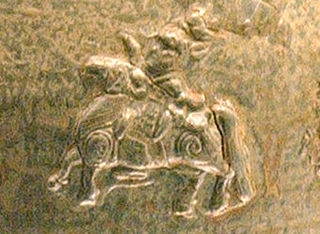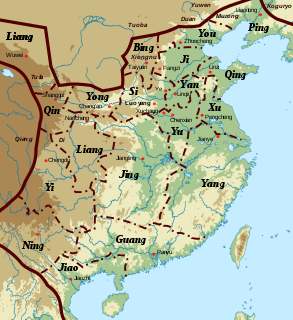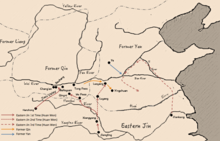
The Battle of Fei River or “Feishui” was a battle in 383, where Fu Jiān of the Di Former Qin Empire was decisively defeated by the numerically inferior Jin army of Eastern Jin.. The battle is considered to be one of the most significant battles in the history of China. The aftermath of the battle includes the Former Qin Empire falling into massive civil war and its eventual destruction, ensuring the survival of Eastern Jin and other Chinese regimes south of the Yangtze River.
Wang Meng, courtesy name Jinglüe (景略), formally Marquess Wu of Qinghe (清河武侯), served as prime minister to the Former Qin emperor Fu Jiān in the fourth century. Under his governance, Fu Jiān's empire expanded from encompassing only most of Shaanxi, eastern Gansu, and extreme western Shanxi and Henan, to covering nearly all of then-Chinese territory north of the Huai River and the southwest. He is commonly regarded as one of the greatest statesmen in Chinese history.
Fu Jian, courtesy name Yonggu (永固) or Wenyu (文玉), formally Emperor Xuanzhao of (Former) Qin ( 秦宣昭帝), was an emperor of the Chinese/Di state Former Qin, under whose rule the Former Qin state reached its greatest glory—destroying Former Yan, Former Liang, and Dai and seizing Jin's Yi Province, posturing to destroy Jin as well to unite China, until he was repelled at the Battle of Fei River in 383. For a variety of reasons, the Former Qin state soon collapsed after that defeat, and Fu Jian himself was killed by his former subordinate, Yao Chang the founding emperor of Later Qin, in 385.
Empress Kezuhun was an empress consort and empress dowager of the Chinese/Xianbei state Former Yan. Her husband was Murong Jun, who was succeeded by their son Murong Wei.
Murong Wei, courtesy name Jingmao (景茂), formally Emperor You of (Former) Yan was the last emperor of the Xianbei state Former Yan. He became emperor at age 10 and, late in his reign, with powers in the hands of his mother Empress Dowager Kezuhun and his incompetent and corrupt granduncle Murong Ping, was captured by Former Qin's prime minister Wang Meng in 370, ending Former Yan. Later, during the middle of Former Qin's collapse after its defeat at the Battle of Fei River in 383, he tried to join his brother Murong Chong in rebellion and was executed by Former Qin's emperor Fu Jiān in early 385.
Huan Wen (桓溫) (312–373), courtesy name Yuanzi (元子), formally Duke Xuanwu of Nan Commandery (南郡宣武公), was a general of the Jin Dynasty (265-420). He is commonly viewed as one of the greatest generals since Jin's loss of northern China, as he led the campaign that destroyed Cheng Han and annexed its lands to Jin, and had some successes against the northern states Former Qin and Former Yan. After his death, the Huan clan would be entrenched in the Jin power struction for decades, after his son Huan Xuan temporarily usurped the Jin throne in 403 as the emperor of Chu (楚), he was posthumously honored as Emperor Xuanwu of Chu with the temple name of Taizu (太祖).
Murong Ping (慕容評) was a regent of the Chinese/Xianbei state Former Yan during the reign of Murong Wei, after the death of the previous, far more capable regent Murong Ke. He, along with Murong Wei's mother Empress Dowager Kezuhun, is often blamed for Former Yan's decline and fall.
Murong Yong, courtesy name Shuming (叔明), was the last emperor of the Xianbei state Western Yan. He was the grandson of Murong Yun (慕容運), the uncle of Former Yan's founder Murong Huang. As a member of Former Yan's imperial clan, he was moved to Guanzhong, Former Qin's capital region, when Former Qin destroyed Former Yan in 370. He was described as poor, and he and his wife made their living by selling boots.
Murong Chui, courtesy name Daoming (道明), Xianbei name Aliudun (阿六敦), formally Emperor Chengwu of (Later) Yan ( 燕成武帝) was a great general of the Chinese/Xianbei state Former Yan who later became the founding emperor of Later Yan. He was a controversial figure in ancient China history, as his military abilities were plain, but as he was forced to flee Former Yan due to the jealousies of the regent Murong Ping, he was taken in and trusted by the Former Qin emperor Fu Jiān, but later betrayed him and established Later Yan, leading to a reputation of him as a traitor. Further, his reputation was damaged in that soon after his death, the Later Yan state suffered great defeats at the hands of Northern Wei Dynasty's founder Emperor Daowu, leading to the general sense that Murong Chui contributed to the defeats by not building a sound foundation for the empire and by choosing the wrong successor. Murong Chui's biography in the Book of Jin described him as seven chi and seven cun tall and having long arms.
Xie Xuan (謝玄) (343–388), courtesy name Youdu (幼度), formally Duke Xianwu of Kangle (康樂獻武公), was a Jin Dynasty (265-420) general who is best known for repelling the Former Qin army at the Battle of Fei River, preventing the Former Qin emperor Fu Jiān from destroying Jin and uniting China.
Zhai Liao one of the Leader of the West Ding Ling horde, was the founder of the Chinese/Dingling state Wei. The first Ding Ling Siberian established a nation in ancient China. During his reign, he was the "Heavenly King", same title to emperor.
Murong Bao, courtesy name Daoyou (道佑), Xianbei name Kugou (庫勾), formally Emperor Huimin of (Later) Yan ( 燕惠愍帝), temple name Liezong (烈宗) or Liezu (烈祖), was an emperor of the Chinese/Xianbei state Later Yan. He inherited from his father Murong Chui a sizable empire but lost most of it within a span of a year, and would be dead in less than three, a victim of a rebellion by his granduncle Lan Han. Historians largely attributed this to his irresolution and inability to judge military and political decisions. While Later Yan would last for one more decade after his death, it would never regain the power it had under Murong Chui.
Murong Nong (慕容農), formally Prince Huanlie of Liaoxi (遼西桓烈王), was a general and imperial prince of the Chinese/Xianbei state Later Yan. He was a son of the founding emperor Murong Chui and a brother of Murong Bao. Throughout most of the state's history, he was admired by the people and officials alike for his military and governance abilities, but his inexplicable failures in 398 helped to lead to the downfall of himself, his brother Murong Bao, and the Later Yan state.
Murong Long (慕容隆), formally Prince Kang of Gaoyang (高陽康王), was a general and imperial prince of the Chinese/Xianbei state Later Yan. He was a son of the founding emperor Murong Chui and a brother of Murong Bao, and when his brother's empire was under threat from the rival Northern Wei's prince Tuoba Gui, he tried to save it, but was killed by his nephew Murong Hui, intent on seizing power from both his father and his uncles.
Murong Lin, Xianbei name Helin (賀驎), was a general and imperial prince of the Chinese/Xianbei state Later Yan. He was a son of the founding emperor Murong Chui and a brother of Murong Bao ; for a while, he himself was a pretender to the Later Yan throne. He was known both for his abilities and his treachery, and he betrayed both his father and his brothers Murong Ling (慕容令) and Murong Bao on separate occasions. Eventually, he was executed by his uncle Murong De, the founder of Southern Yan.
Murong De, name changed in 400 to Murong Beide (慕容備德), courtesy name Xuanming (玄明), formally Emperor Xianwu of (Southern) Yan ( 燕獻武帝), was the founding emperor of the Chinese/Xianbei state Southern Yan. He was the son of Former Yan's founding prince Murong Huang and younger brother to both Former Yan emperor Murong Jun and Later Yan emperor Murong Chui, and therefore was an imperial prince and general during the times of both states. After Murong Chui's son Murong Bao lost most of Later Yan's territory to Northern Wei, Murong De took troops under his own command south and established Southern Yan, which secured modern Shandong, but failed to expand further, and was destroyed by Jin Dynasty (265-420) after Murong De's death and succession by his nephew Murong Chao. Book of Jin (晉書) described Murong De as having a stalwart and extraordinary appearance and was about two metres tall.

Battle of Canhe Slope (參合陂之戰) refers to a battle in 395 where the Chinese/Xianbei state Later Yan, then ruling over northern and central China, had launched a punitive campaign against its former vassal Northern Wei, also of Xianbei extraction. Later Yan forces were led by its crown prince Murong Bao and enjoyed some initial successes, but after being frustrated by the containment strategy of Northern Wei's prince Tuoba Gui, withdrew. Tuoba Gui then gave chase and crushed Later Yan forces at Canhe Slope (Canhebei,参合陂). He captured a large number of Later Yan forces, but in fear that releasing them would allow a future Later Yan campaign against Northern Wei, slaughtered them. The battle reversed the power relations between Later Yan and Northern Wei. After Later Yan's emperor Murong Chui died in 396 and Murong Bao succeeded to the throne, Northern Wei would launch a debilitating campaign of conquest against Later Yan, and by 398 had captured most of Later Yan's territory, reducing Later Yan to a small regional state.

The Jin dynasty (265–420) was one of China's most crucial dynasties. Following the devastation of the Three Kingdoms period, the Jin unified those territories and fostered a brief period of prosperity between 280 and 304 CE. However, during this period many social problems developed as well, the most pressing of which was the migration of barbarian tribes into Jin territory, to the point where they outnumbered Han Chinese in some regions.

The Sixteen Kingdoms, less commonly the Sixteen States, was a chaotic period in Chinese history from 304 to 439 CE when the political order of northern China fractured into a series of short-lived dynastic states, most of which were founded by the "Five Barbarians," non-Chinese peoples who had settled in northern and western China during the preceding centuries and participated in the overthrow of the Western Jin dynasty in the early 4th century. The kingdoms founded by ethnic Xiongnu, Xianbei, Di, Jie, Qiang, as well as Chinese and other ethnicities, took on Chinese dynastic names, and fought against each other and the Eastern Jin dynasty, which succeeded the Western Jin and ruled southern China. The period ended with the unification of northern China in the early 5th century by the Northern Wei, a dynasty established by the Xianbei Tuoba clan, and the history of ancient China entered the Northern and Southern dynasties period.

The military history of the Jin dynasty encompasses the period of Chinese military activity from 266 AD to 420 AD. The Jin dynasty is usually divided into the Western and Eastern Jin eras. Western Jin lasted from its usurpation of Cao Wei in 266 to 316 when the Uprising of the Five Barbarians split the empire and created a number of barbarian states in the north. The Jin court fled to Jiankang, starting the era of Eastern Jin, which ended in 420 when it was usurped by Liu Yu, who founded the Liu Song dynasty.





